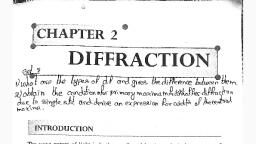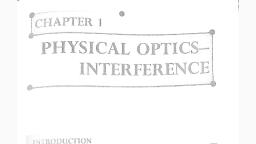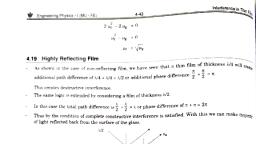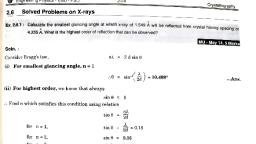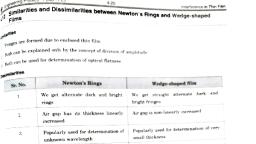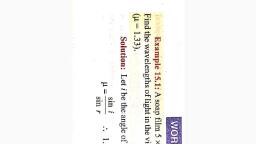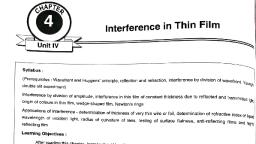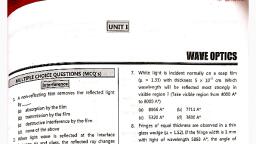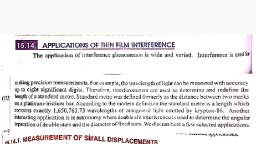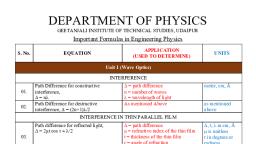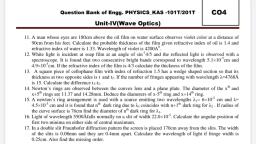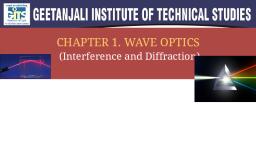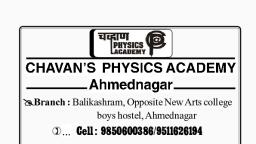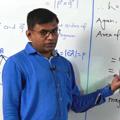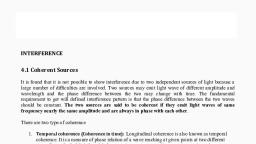Page 1 :
SOLVED PROBLEMS, , 1. A parallel beam of light of 6000A is incident on a thin glass plate of, refractive index 1.5 such that the angle of refraction into the plate is, 50°. Find the least thickness of the glass plate which will appear dark, , by reflection., , Given data Wavelength of the given light A= 6000A = 6000 x 10% cm, , Refractive index of the glass plate y= 1.5, Angle of refraction r = 50°, , , , Solution Qut cosr=na, For least thickness, 1 = 1, . na, Thickness f =, 2ucosr, , i 1 x 6000 x 10°, “2x 1.5 x cos 50°, , (= OX 10°, ~ 3 x 0.6428, , =3.11x10°cm, , =3.1114x 10° cm, , 2. Ina Newton’s rings experiment, the diameter of the 5" ring is 0.30 cm, and the diameter of the 15" ring is 0.62 cm. Find the diameter af the, 25" ring., , Given data Diameter of the 5" ring = 0.3 cm, Diameter of the 15" ring = 0.62 cm
Page 2 :
110 © Engineering Physic ‘, : i, , Solution We want diameter of the 25" ring., We know that 2; 1 = A(n ~ mAR, Di De = AS = 5)AR, (0,62)" ~ (0.3) = 40 AR, 0.3844 — 0,09 = 40 AR (i, Similarly, Dog! and p °, D2, - D5 = (25 ~ 5)AR, , =, , 2, Dg ~ 0.09 = BOAR (ii), Dividing Hyg. (ii) by Lig. (i), PE Sak, (0.3844 —0.09 40 AR, D3, = 2.x 0.2944 + 0.09 = 0.6788, Dos = 0.6788 = 0.824 cm, Diameter of the 25" ring is 0.824 cm., 3. Aconvex Jens on a plane glass plate is exposed toa monochromatic light., The diameter of the 10" dark ring is 0.433 cm. Find the wavelength of, the light used if the radius of curvature of the lens is 70 cm., , Given data Radius of curvature, R = 70cm, Diameter of the 10" ring = 0.433 cm, , Soluti A=, somten 4nR, , (0.433) _ 0.187 -5, _ 0.433)" _ 0.187 _ 6.6786 x 10, Zit oer, , 4. A soap film with a refractive index of 1.33 and thickness of 5000 A, is exposed to white light. What wavelengths in the visible region are, , reflected?, 7, , Given data Refractive index of the soap film, po = 1.33, Thickness of the film, 1 = 5000, , Solution Condition for maximum reflection is, , A =5000 x 107'°m, , Qut cos r=(2n + 1) 4 where n = 0, 1, 2, etc., , Assume cos r= 1, Then = fet 4x 1.33 x 5000 x 10", (2n + 1) (2n + 1)
Page 3 :
@-— — ey Bel, , = 0000: x 10!, , a, , (2n +1), , When n=0, 2, =26600x%10% Mm Cinfrared region), , _ 5 . 26600 x 10°! 1, he = 16 x IO, When nel, A,= a — = $66.7 x 10°'?m (UR), 5 , _ 26600 « 19" 0 ici i, n=2. A,= — — = §320x10'' m_ (visible region), 5 hers (, ta3. Ga 20000 % 10, , % : 3800 x10 m, , ], , (ultraviolet region), , AHL wavelengths reflected, at wavelength 5320A the visible regions are, reflected., , 5. What is the thickness of the thinnest film of 1.33 refractive index in, , which destructive interference of the yellow light (6000 A) of a normally, , incident beam in air can take place by reflection?, , Given data Refractive index of the film, fi = 1.33, Wavelength of yellow light 2 = 6000 A = 6000 x 10 Som, Angle of incidence i = 0°, ». r= 0° (reflection), For least thickness, 1 = 1, Solution Qurcosr=na, , a na, , ~ 2p cos r, , _ 1x 6000 x 10%, ~ 2x 1.33 x cos 0°, , , , | _, — 0X10” 2.255 x 105 em, 2.66 x 1, -. The thickness of the thinnest film = 2,255 x 10° cm, , 6. Ina Newton’s rings experiment, the diameter of the 8" a ring was 0.35, cm and the diameter of the ig! ring was 0.65 cm. If the wavelength of, the light used is 6000A then find the radius of curvature of the planoconvex Jens., , Diameter of the 18" ring = 0.65 cm, , Diameter of the 8" ring = 0.35 cm, , Wavelength of the light, A= 6000 A, Solution Radius at naauaiire: of the plano-convex lens is, , he 2 Diy, , A(n— mA
Page 4 :
Engineering Phy stes, , , , 112 @——_____—_—__ :, (0.65) — (0.35)", => R= pe = 7, 4(18 -% x 600 x 10°, 225 —0.1225 _ 0.3, = ia 0.12 = oS x 10" = 125 em, 24 «x 107 24, , ~ Radius of curvature of the plano-convex lens is 125cm., 7. Ina Newton's rings experiment, the diameter of the 12" ring changes, from 1.45cm to 1.25cm when a liquid is introduced between the lens, and the glass plate. Find the refractive index of the liquid., , Diameter of the 12" ring in air medium, Dy) = 1.45em, , Given data, iil ea fii bata TR , 5, 12'" ring in a liquid, D";) = 1.25cm, , Diameter of the, , Solution De = ae, (Dv = ait = 4x tar “= | for air, wight ean, From the above relation,, , fo 3= 3 = Tens, (Dis) (1.257 1.5625, ©. Refractive index of the liquid is 1.3456., 8. In a Newton’s ring experiment, the diameter of the Sth dark ring 1s, 0.3 em and the diameter of the 25" ring is 0.8 cm, Hf the radius of, curvature of the plano convex lens is 100 em, find the wavelengths ol, , the light used., Given Data Diameter of 5" dark ring D, = 0.3 em, Diameter of 25"" dark ring Dy, = 0.8 em, Radius of curvature of plano convex lens. R= 100.em, Solution Hesse, din — mR, _ O8Y = (0.3/9, 48 ~ 3) x 100, , = $3? x 10% em
Page 5 :
MULTIPLE CHOICE QUESTIONS, , ls, , Nw, , wo, , Two sources :, ' es are si se, ‘tid to be coherent if their emitted waves have, , (a) same amplitude (b), ») cone nee b) same wavelength, (c) constant phase difference (d) all the at ., When a light wave is reflected ; “air j reife, cimeeae tise s cted at the glass-air interface, the change of, ; he reflected wave is equal to, a) 0, b) a/2, (c) a4 6, ad) x, When a li ave is r i, Hie ight wave is reflected at the air-glass interface, the change of phase of, the reflected wave is equal to :, , (a) 0 (b) 7/2, (c) a4 (a) a, In the presence of a plane parallel film, the path difference is equal to, (a) 2uesini (b) 2utcosr, (c) 2usinr (d) 2utcos i, , If a light wave is refracted from air to denser medium then the phase and path, , difference is, (a) mand A, (c) m/2anda, , In a plane parallel fi, for the air film to appear bright?, , (a) 2urcosr= na, , (by mand A/2, (d) a/2 and A/2, Im due to reflected light, what is the condition for maxima, , (b) 2utcosr=(2n+ 1)A/2, (d) 2utcosr= (2n- 1)A/2, , (c) 2tcosr= nal2, the condition for minima, , In a plane parallel film due to reflected light, what is, , for the air film to appear dark?, , (a) 2p tcosr = nAl2 (b) 2urcosr=(2n + IA/2, , (c) 2p tcosr= nd (d) 2utcosr = (2n— LA2, , In Newton’s rings, interference is, (a) upper surface of lens and upper surface of glass plate, (b) lower surface of lens and upper surface of glass plate, , f glass plate and upper surface of lens, , due to light rays reflected from, , (c) lower surface 0:, face of lens and lower surface of glass plate, , (d) lower sur’, In Newton’s rings experiment, what is the condition for bright fringes in case of, , reflected light?, (a) De V2nt1, (c) Devan, , (bl) Den, (d) D« V2n-1
